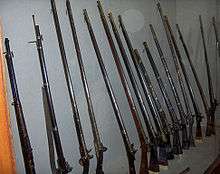Wall gun

Wall guns were large caliber smooth-bore muskets that were used in the 16th through 18th centuries by defending forces to break the advance of enemy troops. They were too heavy to be fired from the shoulder and so were usually rested on window ledges or low walls, hence the name.[1] They were also known as Hackbuts, a name originally given to early medieval hand cannon.[2] Many were fitted with a barrel hook to absorb shock. Some of these weapons had multiple barrels which enabled volleys to be fired much faster than a normal single shot wall gun.
Wall guns were used in India as early as the 17th century[3] and there is a Burmese source from the late 15th century mentioning the use of "cannon and muskets" by the defenders of the besieged town of Prome.[4] There are examples of later wall guns fitted with bipods.[5]
A wall gun's barrel could be over 4.5 feet (140 cm) in length with a bore of at least 1 inch (2.5 cm). This made them more accurate than the standard flintlock or matchlock musket. George Washington acquired several wall guns during the American War of Independence; tests showed that they were capable of hitting a sheet of common writing paper at 600 yards (550 m). Wall guns were part of the standard equipment of some artillery pieces at that time.[6]
During the Napoleonic Wars many of these guns were cut down and turned into blunderbusses. They fired lead shot and were used by naval boarding parties and coachmen as protection from highwaymen.
A breech-loading wall gun was issued to the French army in 1819 for the defense of towns. Improved caplock versions were introduced in 1831 and 1842,[7] as were muzzleloading versions. Bolt action wall guns firing metallic cartridges were used in India and China in the late 19th century.[8]
Naval uses
When HMS Espoir captured the Genoese privateer Liguria on 7 August 1798, Espoir's captain, Commander Loftus Otway Bland, catalogued Liguria's armaments as: 12 long 18-pounders, four long 12-pounders, 10 long 6-pounders, 12 long wall-pieces, and four swivel guns. While wall-pieces were stocked similar to a musket, though would often have a forged yoke to help support the gun, and in some cases were rifled. Mentions of wall guns are rare in such enumerations; what is more common are mentions of the "swivel guns". A swivel gun commonly resembled a very small cannon and so did not have a shoulder stock, and was mounted at a central point as was the wall-piece, so that it would "swivel" [hence the name]. These would have been smooth bore, and could have a bore from 1" to 2", launching ball as heavy as one or two pounds. However, the swivel gun was very effective when used as a large shotgun and was more commonly used as such, firing several smaller balls at one time, at close range targets, such as men trying to board from an enemy ship alongside. A 2" bored swivel gun could launch 64 ½" balls.
See also
References
- ↑ Flintlock Wall Gun
- ↑ Handgonnes and Arquebuses (3/31/09)
- ↑ Indian Wall Gun
- ↑ Ricketts, Howard (1962) Firearms. (London), p.5.
- ↑ Stone, George Cameron and Donald J. LaRocca (1999) A glossary of the construction, decoration, and use of arms and armor in all countries and in all times: together with some closely related subjects. (Dover) p.265.
- ↑ "Work Begins," The Cannon Project by Colonial Williamsburg. Accessed September 15, 2009
- ↑ H Colburn, United Service Magazine (1852) p.419
- ↑ McCollum, Ian (February 29, 2012). "Chinese "Jingal" Wall Gun". Forgotten Weapons. Retrieved September 9, 2012.
